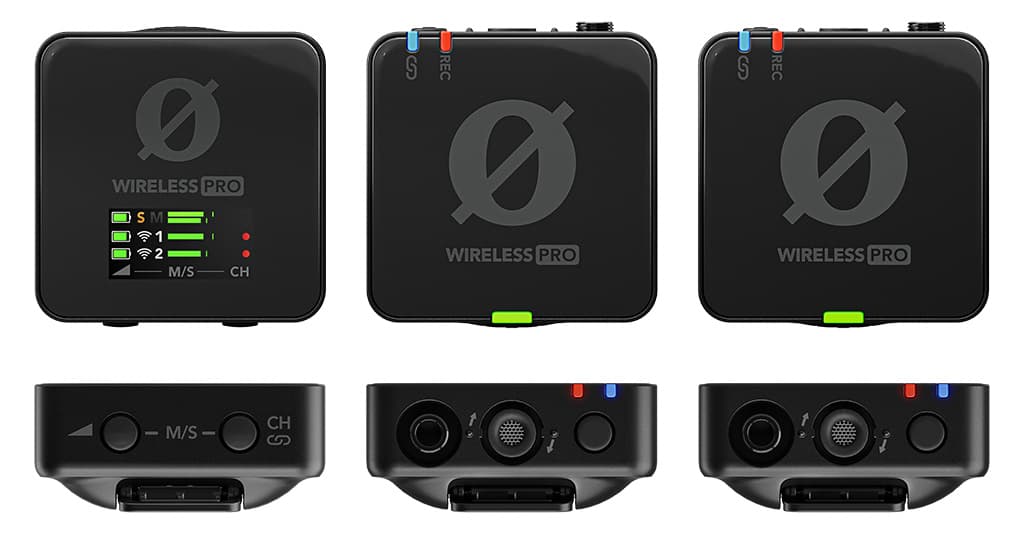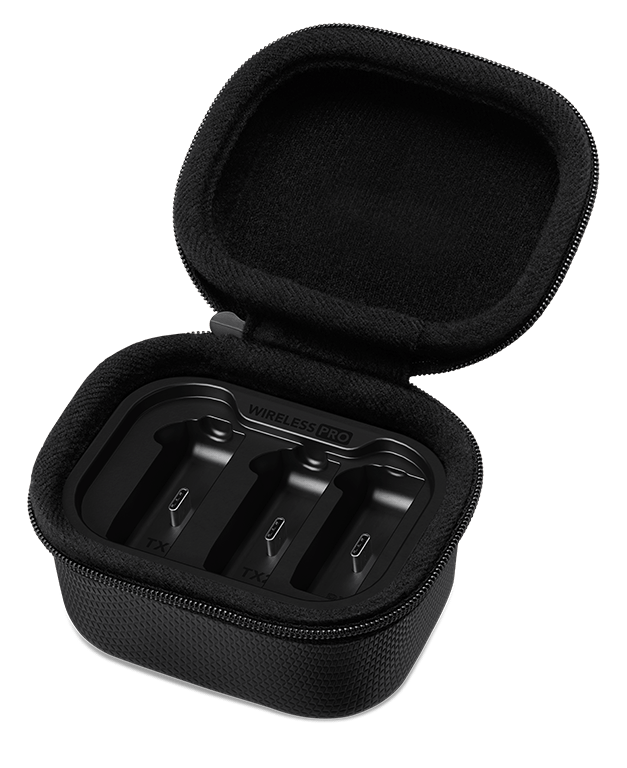
Review: RØDE Wireless PRO
Rode supercharges its flagship wireless microphone system for videographers with 32-bit float recording and SMPTE timecode generation.
Review: Corey Hague
The Rode product stable is already deep and diverse, with products catering to seemingly everyone – recording studios, podcasters, mobile content makers, venues and video shooters. And now Rode has introduced the Wireless PRO (yes, the ‘pro’ is capitalised), a video-focused wireless microphone kit that packs a lot of promise into its small frame. But does it live up to the capitalised name?
Opening the package and it’s off to a promising start. There’s enough bundled into the kit to deal with almost any situation a typical videographer is likely to encounter. Two wireless transmitters, one receiver, two threaded lavalier microphones, a short 3.5mm to 3.5mm coiled cable, two different sets of dead cats, various clips and magnets, a USB-C-to-Lightning cable and enough USB-C cables to be useful. These are all housed snugly across two small cases: one acts as charger/battery for the transmitters (think Airpod holder/charger) while the other contains the various accessories.
JUST IN CASE
The cases are almost identical, save for the weight. The charging dock is undoubtedly clever and very welcome – the unit has enough juice inside it for two full extra charges away from any power source. However, the decision to package a Wireless PRO system across two cases is a little confusing. There’s not enough space in the charger case for the various accessories you’re likely to want to have with you, so you’re most likely going to always need to take two cases with you anyway. It’s not a show-stopping issue, however it seems like a complication when it comes to packing out a shooting kit, and it’s not difficult to envision nightmare scenarios where the wrong case is packed, or even worse, left behind.
There’s a lot more to Wireless PRO than its transport cases. The transmitter/receiver combo is the star of the show and they’re instantly impressive pieces of kit. Sharing the same form factor as the Wireless Go and Wireless Me units, they’re similar in size and feel to a smartwatch — well built, and with just enough heft to appreciate that it’s a cutting-edge piece of tech. The trio are almost exactly the same size and shape, but the receiver is differentiated by having a small LCD screen built into it. Crisp and bright, the screen conveys level meters and important parameter settings with a minimum of fuss. There’s no real menu-diving required to get up and running, and the screen is easily readable in full sunlight and dark spaces alike. Syncing the transmitters to the receiver is effortless, and the three-button operation required to get up and running is intuitive straight out of the box.
BECAUSE I’M APP-Y
Like any modern gadget, as soon as it connected to my phone it wanted to do an update, which thankfully was quick and pain-free. Once updated, it then launched the app store, where three apps were recommended to me. After a quick search online, two seemed to be relevant to my needs – Rode Capture and Rode Central. Unsurprisingly, the Capture app is centred around recording video, while Rode Central allows you to Bluetooth into the receiver and get into the nitty-gritty of the unit and manipulate its settings and functions.
NEED TO KNOW
RØDE Wireless PRO
Dual-Channel Microphone System

Requiring apps to make technology work is the new norm, and Rode deserves praise for how it has approached the task of interfacing with the units. No sign-ups or logins or passwords or accounts or adverts or extra steps; simply connect and then make your selections. It’s a seamless affair that some other manufacturers should pay close attention to. Even using the app in extreme conditions would be painless, unlike other apps that require data coverage and logins just to make changes to a device.
Once you’re connected with the Rode Central app, you can peek under the bonnet and see what the PRO can really do. SMPTE timecode generation is a notable addition to this system that’s sure to please multicam shooters who rely on timecode to keep footage aligned across cameras. There are a few different timecode routing options which should cover most typical situations and cameras.
32-BIT FLOAT
Another big addition to the Wireless PRO is 32-bit float recording built into the units. Ask any run-and-gun videographer what the hardest part of filming is and most will tell you it’s recording good audio. Wireless lavalier kits are famous for somehow being both too loud and too quiet at exactly the same time, often resulting in frustrating edits and anxiety just trying to get usable interview audio. Without falling down a mathematical rabbit hole, it’s safe to say the 32-bit float format has quickly been embraced by the video crowd for its extremely forgiving nature when it comes to dynamics, specifically how it copes with clipping and noise floor.
So can we finally stop worrying about setting perfect levels thanks to 32-bit float recording on the Wireless PRO? Functionally, the answer is ‘yes’. In practice, you really can just relax and let the internal recording take care of capturing clean audio. There’s very little downside to the new format, and the Rode Central software wrangles the files quickly and easily so you can get them into your favourite editor. Once you start to work with the files, the benefit of 32-bit float recording is evident – you really can push the results further than standard 16-bit recordings. It feels similar to the difference between RAW photography and JPEG in terms of latitude in post production and the benefits far outweigh whatever workflow changes it requires.
can we finally stop worrying about setting perfect levels thanks to 32-bit float recording on the Wireless PRO? Functionally, the answer is ‘yes’
Even when examining waveforms closely, spikes and pops that should have clipped aren’t actually square and crunchy, while, at the other end of the spectrum, quiet recordings are easily boosted to usable levels. This doesn’t mean that wind or handling noise is suddenly sonically pleasing or wanted, but it does represent a real leap in capturing audio and it’s likely to fast become the standard for any recorder designed for fieldwork.
SMART & NIMBLE
Using the Wireless PRO with both smartphones and cinema cameras was straightforward and delivered solid results. The buttons on the units allow you to quickly get your output levels right and the screen gives you all the useful info required. Being able to record audio separately with each transmitter opens up lots of flexibility to how you work; much fun can be had in treating one transmitter as a traditional interview mic with another acting as a location recorder. Thanks to the small size and its handy clip, you can even treat it as a kind of GoPro for audio, allowing you to get usable recordings in a variety of unique ways that would have previously been cumbersome. This will be particularly handy for shooting live performances, where you frequently have to blend different audio sources in an edit.
While the Wireless PRO is squarely focused on the video crowd, it makes a strong case for itself in other areas too – podcasters, field recordists and venues would all benefit from how speedy and adaptable it is, and that’s not taking into account the fact that the receiver can also act as an audio interface for computers. It’s an extremely capable and versatile piece of kit that, above just doing its job well, should also solve many of the typical problems that crop up on a shoot or event.
The wireless lavalier market is already crowded with worthy contenders, but Wireless PRO is the most evolved in the space and does more than others in the price bracket by a good margin. Wireless Pro will happily replace the ageing wireless lavs in my own kit. Not because it’s more ‘pro’, but rather because it’s more user friendly, more forgiving and more suited to capturing clean audio without the need for a dedicated sound operator. The Wireless PRO is another hit for Rode and represents the next era in wireless sound at a competitive price.




























RESPONSES